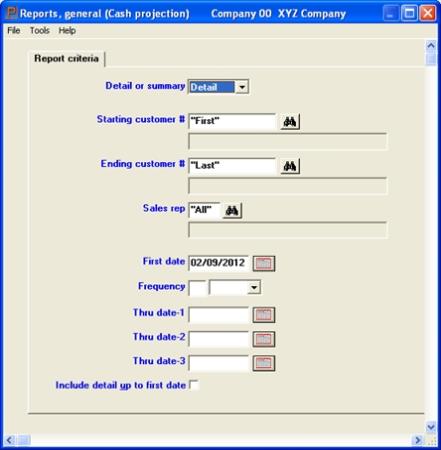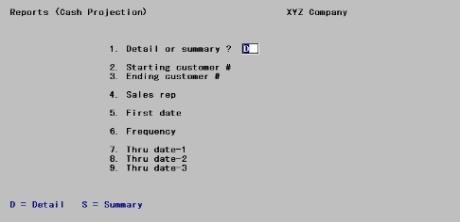
This chapter contains the following topic:
Introduction to the Cash Projection Report
The Cash projection report selection enables you to project cash flow by showing receivables that are coming due over a given period.
Each customer’s account is aged by due date for this report, using the aging method (balance forward or open item) entered for each customer in Customers. Refer to the Aging Report chapter, for a full discussion of aging by due date for balance forward and open item customers.
Select
Cash projection from the Reports, general menu.
A sample Cash Projection Detail Report is in the Sample Reports appendix.
The following screen appears:
Graphical Mode

Character Mode

Enter the following information:
Select Detail or D to print a detailed or Summary or S to print a summary report.
The summary report shows the total account balance for each aging period, while the detailed report shows all items for each customer in addition to the aging balances.
|
Format |
Graphical: Drop-down list, either Detail or Summary. The default is Detail. Character: One letter, either D or S. The default is D. |
|
Example |
Press <Enter> |
Starting customer # and
Ending customer #
Specify the range of customer numbers to include.
Options
You may use the option:
|
<F2> |
For the First starting customer number or Last ending customer number |
|
Format |
12 characters |
|
Example |
Press <F2> at each field |
If you specified in Control information that you do not use sales representatives, this field is skipped.
Otherwise, enter the code of the sales representative whose customers you wish included on the report. This must be a valid entry in Sales reps. Customers are selected for inclusion on the basis of the current sales representative entered for them in Customers, but sales made to those customers are included on the projection even if made by a different sales representative.
Options
You may use one of the options:
|
<F1> |
For the next sales representative |
|
<SF1> |
For the previous sales representative |
|
<F5> |
To include customers for All sales representatives |
|
Format |
3 characters |
|
Example |
Type 10 |
You specify the cash projection time periods by entering a beginning date and the size of the periods (days, weeks, or months).
Enter the beginning date for which you want to view projected cash. This can be either past or future, but is normally on or near the current date.
Options
You may use the option:
|
<F2> |
For the current date |
All receivables which are due on or before this date will be shown in the first column on the report. These receivables are thus the receivables which are overdue or should be received by the current date.
|
Format |
MMDDYY |
|
Example |
Type 33199 |
This is the size of the period for each projection. It is entered in two subfields:
| • | A number to specify how many time periods elapse between cash projections. |
| • | A code for the time period. The choices are: |
Options
You may use these options:
|
D |
Days |
|
W |
Weeks |
|
M |
Months |
The frequency is not actually used in calculating the report; it is merely a convenient means of generating the Thru date-1 to 3 fields automatically. The Frequency field is required, even though you can override it when you enter the Thru date-1 to 3 fields.
|
Format |
99 for the number of time periods Graphical: Drop down selection for time periods: Days, Weeks or Months Character: One letter from the list above |
|
Example |
Type 1 Type M |
Thru date-1
Thru date-2 and
Thru date-3
The report shows projected cash in four time periods. Fields #7 through 9 define the boundaries between those periods. The dates must be in ascending time sequence, and all three must be later than the First date in Field #5.
The first period runs from the first date through date-1, the second period from the day after that through date-2, and so on. The fourth period starts on the day after date-3 and runs into the indefinite future.
|
Format |
MMDDYY The default is the date previously entered, plus the specified frequency. Frequencies expressed in days or weeks are calculated to the exact day. Frequencies expressed in months are calculated as the same calendar day of a different month, except where adjustments are required because of different month lengths. |
|
Example |
Press <Enter> at each field |
Include detail up to first date
This field only appears if you are printing a detail report.
If so, check the box or answer Y if you want detail preceding the first period to be included. Uncheck the box or answer N if you do not.
|
Format |
Graphical: Check box where checked is Yes and unchecked is No Character: One letter, either Y or N |
|
Example |
Answer Y |
Click on OK to print the report.
In character mode, make any needed changes, then from Field number to change ? press <Enter>.
There will be a period of processing as printing occurs.